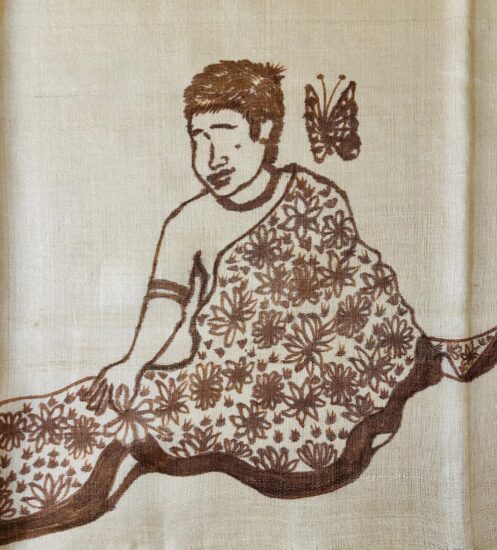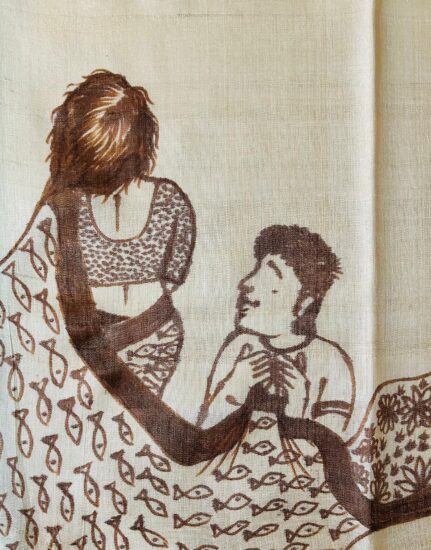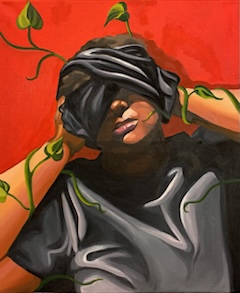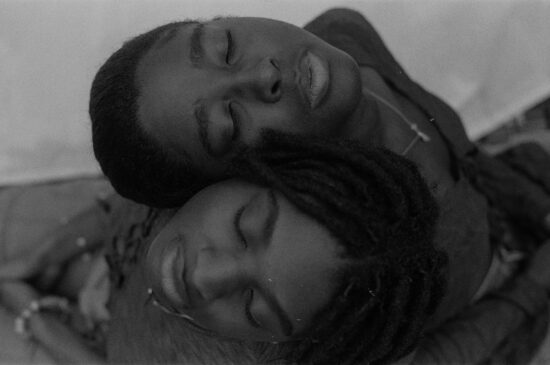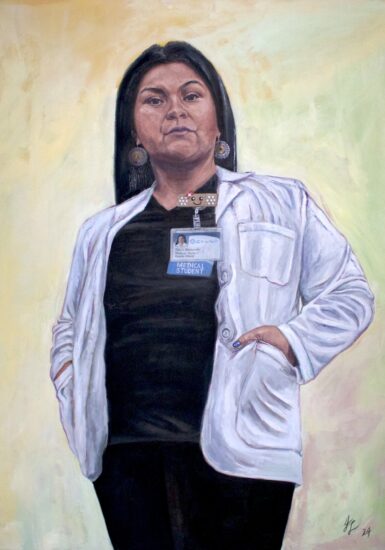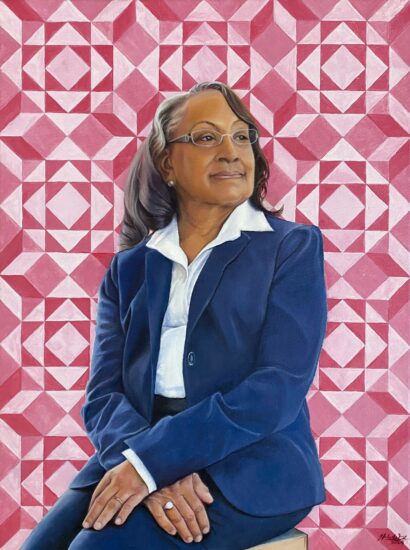
Arts + Justice: 2024 Grant Recipients
The 2023-24 Arts + Justice Student Grant funded twenty students engaged in creative pursuits around questions of art and justice. This year’s cohort includes both undergraduate and graduate students who work in an array of mediums and forms.
The student cohort also received the support of an expanded workshop program, led by graduate student coordinator Marina Bergenstock (Ph.D. candidate in Theater and Performance Studies). The aim of these meetings is to build community and create a space where the group could share goals, challenges, progress, and successes. In this space, the students worked across media, providing invaluable feedback and creating kinship and relationships that will extend far beyond the length of these projects. Marina invited guest presenters who are artist-scholar activists to speak to the group, allowing the participants to think beyond their individual projects and into the wider networks to which they belong or of which they aspire to be part.
Made possible with the generous support of the Shenson Fund, the Arts + Justice Student Grants program is sponsored by the Stanford Arts Institute (SAI), in cooperation with Institute for Diversity in the Arts (IDA).

AARON ADRIANO | Confluence
Aaron (he/him) is a junior studying Urban Studies and Architecture born and raised in the Bay Area. As a multidisciplinary artist, he makes art that combines urban theory and visual practice toward addressing topics of memory, intimacy, and the communities that raised him. In his free time, you can find him debriefing with friends, giggling, and riding public transit for fun.
Confluence is an ambient light installation created in collaboration with Stanford students Katie Han, Constantinos Gallis, Ethan Petersen, and Lily Laugharn. The installation juxtaposed various images of life and nature to find a common nature between them. For my contribution to the installation, I recorded various close-up clips of my friend's eyes which I stitched together in a single video. In doing so, I aimed to highlight how in urban areas, it's the connections between different people of the city that interweave into each other that form the essential fabric of a city.

MARLON ARIYASINGHE | Genography: Genocide across geographies
Marlon Ariyasinghe (he/him) is a poet, theatre practitioner and researcher from Sri Lanka. He was the Senior Assistant Editor at Himal Southasian. His rapportage has been featured in Reuters, DW, BBC World, WION, The Washington Post, NPR, and other outlets worldwide. He has directed plays in Sri Lanka and Switzerland. His collection of poetry, Froteztology, was published in 2011.
Genography: Genocide across geographies explores human rights violations and justice denied to victims during the last phase of the civil war in Sri Lanka. It contemplates the accusations of war crimes with genocidal intent leveled at the state and armed forces. In the form of a spoken-word performance piece, it delves into the discourse of genocide across different geographies and epistemologies. Genogeography was conceived from my lived experiences as a journalist, activist, poet and performance maker, living in a state that has weaponized legislature, law enforcement and the punitive system to suppress forms of free expression. There is an insidious silence surrounding ongoing conflicts, genocide in Palestine and political projects that can be deemed genocidal. I hope art will provide a safer, compassionate and empathetic space for discussion.

PARAS ARORA | In the Shadow of My Mother’s Saree
Paras Arora is an anthropologist, artist, and writer from Delhi, India. Currently they are a Ph.D. Candidate at the Stanford Department of Anthropology, and a Dissertation Innovation Fellow at the Mellon Foundation and American Council of Learned Societies. Conducting research that ethnographically interrogates the unprecedented rise of assisted living homes for an ageing neurodiverse population in India, Paras seeks to reimagine field-based research practices and outputs through an anti-ableist and queer-affirmative, ethical commitment.
Queer people with feminine gender presentation in South Asian communities are routinely policed through everyday taunts that gesture at their fearful existence under the shadow of their mothers’ sarees. Saree, an unstitched garment draped differently by women across South Asia, constitutes not only a site of exclusion but also an altar of refuge, yearning, and possibility for femme people. Conceptualised by a South Asian queer artist and anthropologist, this project seeks to re-member, reconstruct, and reclaim queer people’s relations of love and longing with their families of origin. This project illuminates how queer South Asians move towards a more just future not always by transcending their familial relations but through an agentive and laborious reworking of relatedness in their communities.

MARIA CHICA JIMENEZ | Sanctuary
Maria Chica-Jimenez is a visual artist and first-year Stanford student interested in the intersections of art history, design, and human rights. She was born in Bogotá, Colombia, and bases her practice in Washington D.C. and California. Working predominantly in acrylic and oil paint, Maria is interested in types of abstraction that evoke the expansiveness and complexities of living, simultaneously leaning into figuration in much of her portraiture. Maria seeks to represent, nourish, and pay attention to the body as it exists within and radiates into the world, applying this perspective to the social commentary within her artwork.
Sanctuary is an exaltation of the vibrancies, urgencies, and internalities involving reproductive choice and bodily autonomy. The two paintings invoke quasi-abstract portraiture to present what it means to exist within and make choices for one’s own body. The paintings exalt the ideas of selfhood, self-ownership, and agency within the physical body, as well as the necessity of community support and hope when faced with political and social invasion.
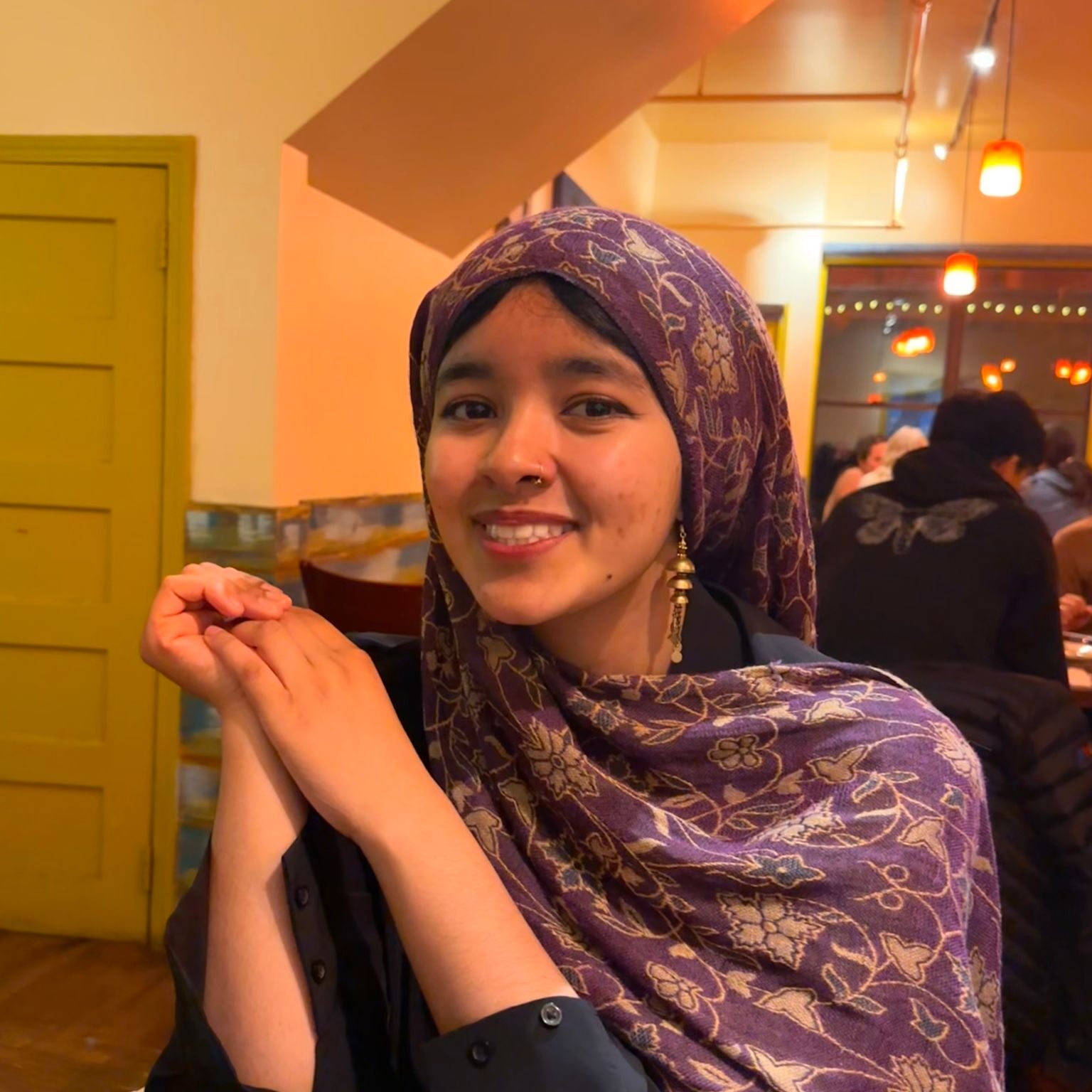
ARWA FARUK | The Sun Will Rise on a Free Palestine
Arwa Faruk is a Muslim, Bangladeshi-American junior from Albuquerque, New Mexico studying Human Biology and Art Practice. Working primarily with oil painting, Arwa centers her memories, humanity’s relationship to the earth, and the flow of Islam through her life, which draw on the nuances of her Muslim Bangladeshi identity and Bengali culture, more broadly. Drawing inspiration from styles of social realism and naturalism, painting is her way of examining and interfacing with the world and people around her. Through visual storytelling, Arwa explores themes of self-reflection, temporality, displacement, and home. Through painting and writing, Arwa hopes to continue to tell stories of common folk in rural Bangladesh, emphasizing our shared humanity.
Translation of text on the painting: With the piercing sword of truth; We'll liberate the land of the free. A painting inspired by Palestinian revolutionary poster art and paintings. Envisioning liberation--through revolution.
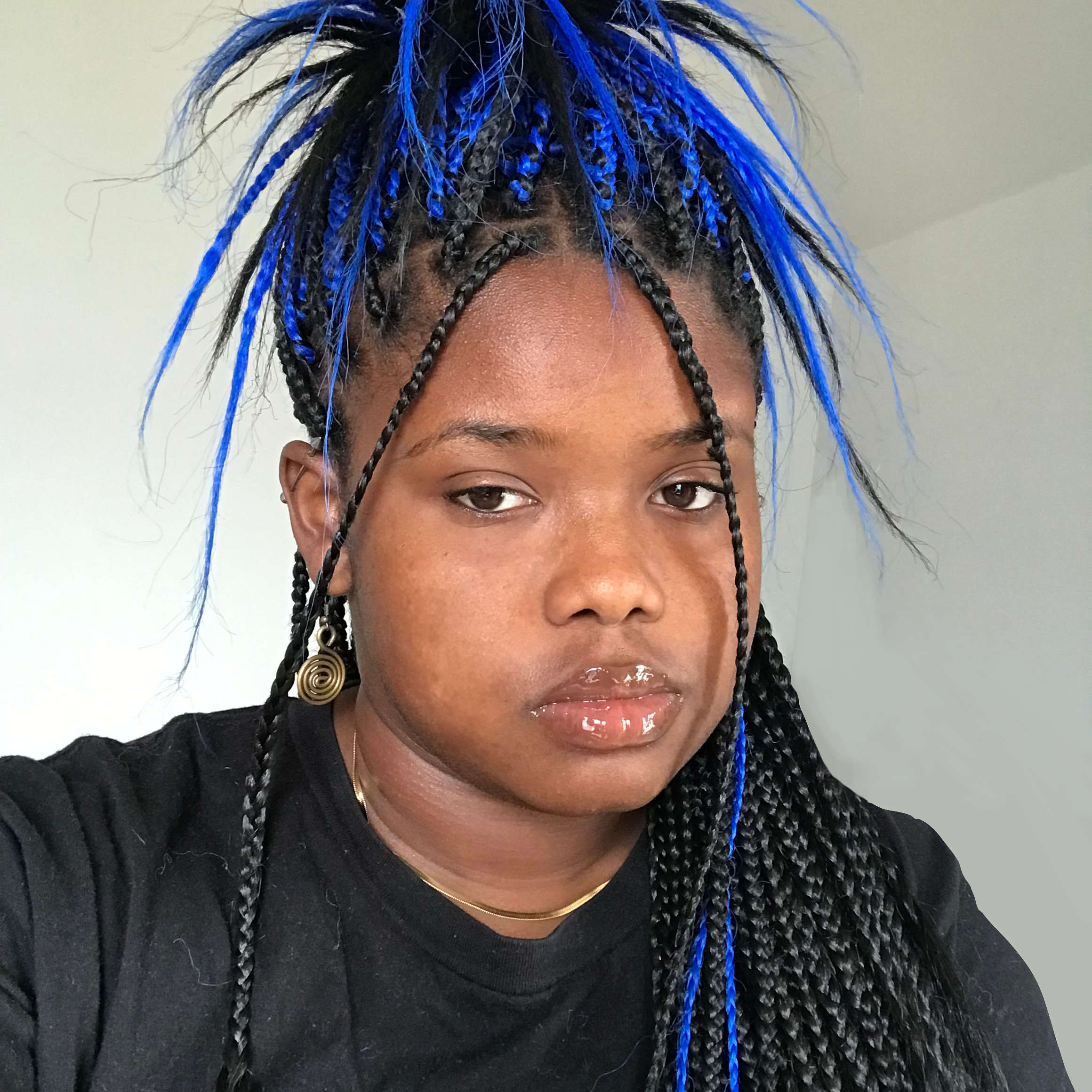
NOVA GOODE | maintenance of the self
My practice began in Richmond, Virginia where I was born and raised. It is now largely based in California, as I am currently a student at Stanford studying art practice. My medium of choice is oil paint, and often expands into other areas such as embroidery and textiles. My work centers Black and brown people, and focuses on topics having to do with mental and emotional wellbeing. Through the lived experiences of my peers, myself, and the works of various scholars I am able to create work that both serves as a visual means of expression, but also a space of reflecting on larger social structures and institutions.
“Caring for myself is not self-indulgence, it is self-preservation, and that is an act of political warfare.” -Audre Lorde
This quote, along with the works of many other Black feminist scholars, poets, and overall creators, were the catalysts behind my project. They inspired me to think critically about what it is that we define as rest and its relations to various larger structures and institutions. Through my pieces, I explore the concept of rest within the confines of Stanford University. My goal for this project was to explore and understand the experiences of students within various marginalized identities(i.e. queer, black, neurodivergent, etc.) and how they engage with rest. I worked toward this goal through a series of interviews with folks I am often in community with (including Noach Macias, Kelli flowers, Sherlock Langevine, and many more who I may not have directly featured within my work, but that had a great deal to do with its creation).
Indeed as many students are aware, while regarded as one of the world's most prestigious institutions of higher education, Stanford University is often the perpetuator of a great deal of violence. That is both in a global context, as well as within the university itself. Through both my own experiences and a series of structured interviews/informal conversations it was made abundantly clear that Stanford is not the utopian site of rest it perpetuates itself to be. It often acts as the exact opposite and promotes students exerting themselves in ways that jeopardize their mental, physical, and spiritual well-being. One could argue (or rather I am arguing) that this is a tactic of maintaining students' ignorance towards the injustices that Stanford commits and or is actively complicit with. I have created these pieces to foster a space of deep thinking around our own practices of rest in addition to the larger communities we play a part.
Are you/your communities allowed to rest? If so...how? What does rest look like within these spaces? If not...in what ways are practices being hindered? What are the larger phenomena creating these hindrances? How do we collectively work together to dismantle such systems?
There are so many more questions we should be asking ourselves, especially within a space such as Stanford. I ask that you sit with my work and ponder such matters. In addition, I ask that we continue to care for our communities so we may all develop a sense of rest, and that we continue to work toward the freedom of all oppressed people.
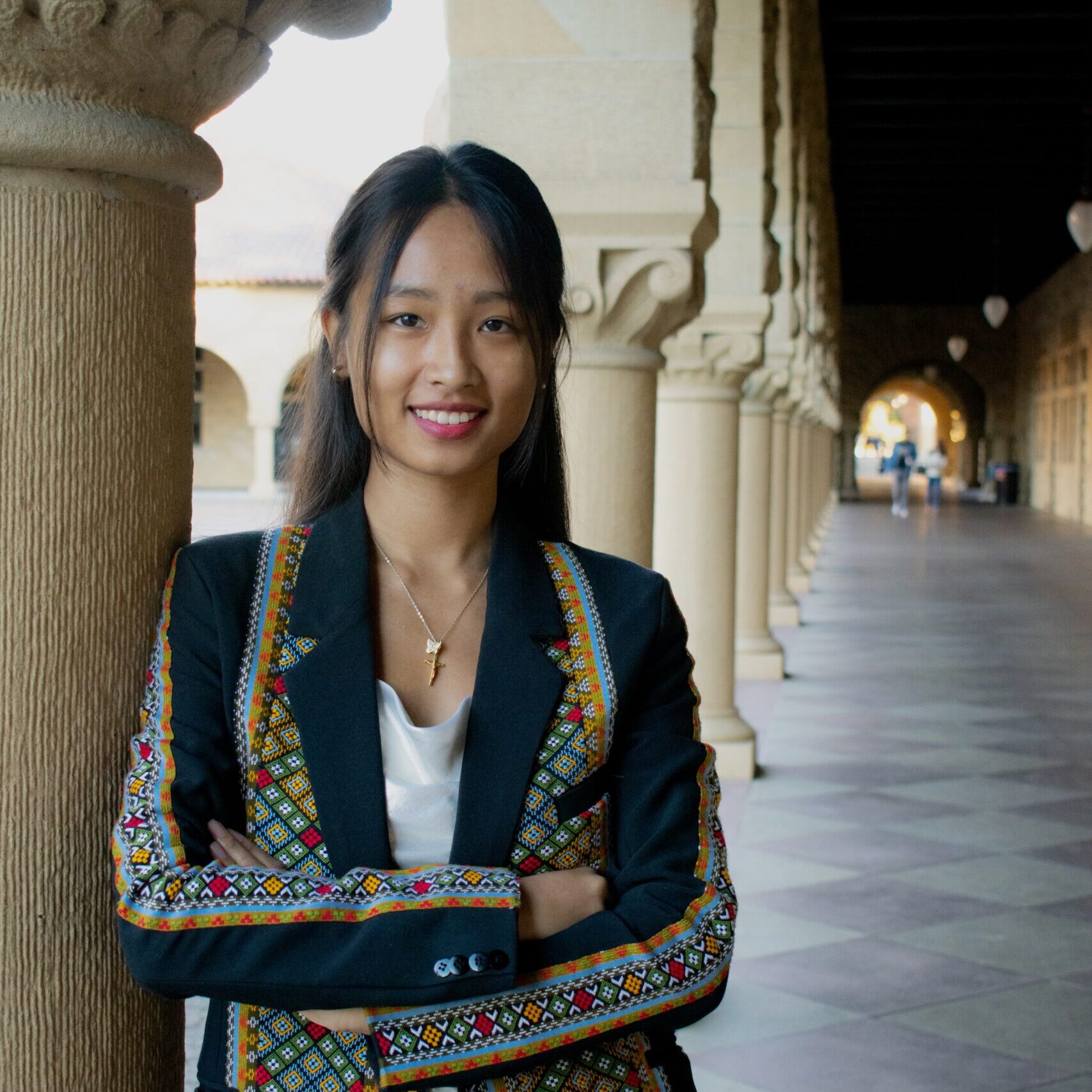
BIAK THA HLAWN | HOME: Preserving the Tthihni
Biak Tha Hlawn, better known as Hlawn Hlawn, was born and raised in Thantlang, Chin State. A daughter to Par Iang Hnem and Lian Kulh Cung and an older sister to three brothers, she draws much of her inspiration for her art from her lived experiences as a refugee. As a multidisciplinary artist studying Design and Sustainability at Stanford, she continuously uses fashion as a form of healing and preserving her Chin culture.
HOME: Preserving the Tthini is Hlawn Hlawn's impassioned journey into the heart of "home" as a resilient refugee. Through her art, she not only designs but breathes life into the soul of her heritage, weaving tradition with a contemporary heartbeat. Each stitch and bead becomes a defiant act of reclaiming identity amid adversity. In her hands, the Chin traditional wear known as tthihni is a bridge between past and present, a resilient echo of a heritage refusing to be silenced. Through her transformative craft, Hlawn Hlawn invites us to witness the beauty emerging from the ashes, igniting a flame of hope that resonates with the universal longing for a place to call home.
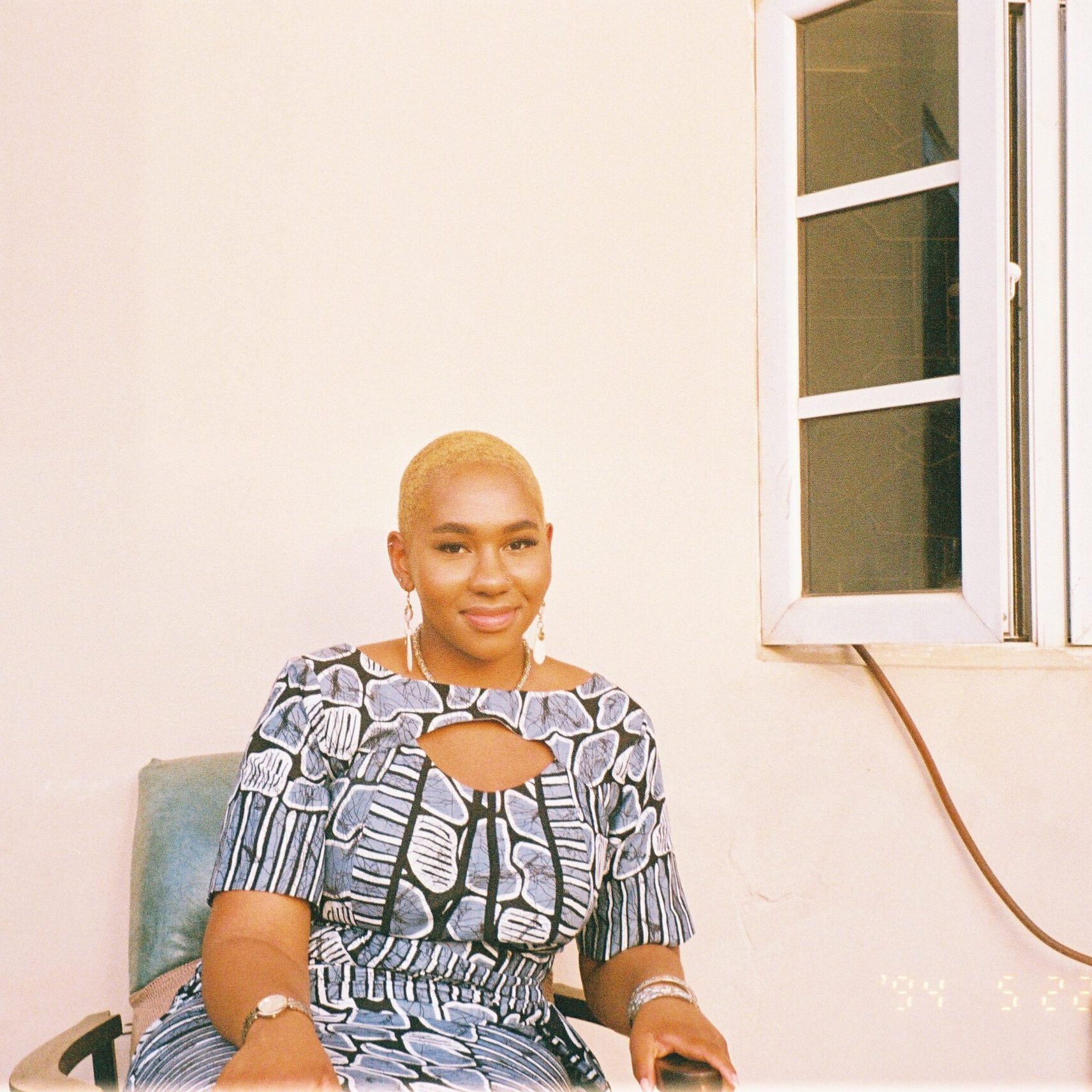
MICHELLE KALU | Reframed
Michelle Ekenma Kalu is a Dallas, Texas and Ohafia native in her third year at Stanford University, majoring in African and African American Studies and International Relations. Her research and art practice focuses on transnational liberation movements across the African diaspora, using photography and sartorial practices from this time period as a medium to understand identity formation in post-colonial contexts. Michelle’s interests lie in human rights advocacy and social justice as well as creative expression and community building in African diasporic communities. She currently serves as the co-president for the Stanford African Students Association (SASA), the executive director of Shaku African dance team, and a student staff member at the First-Generation Low-Income Student Success Center (FLISSC); she has previously supported students through her role as the Equity Community and Leadership Liaison role at the Black Community Services Center (BCSC).
In her free time, Michelle enjoys cooking, dancing, and snapping photos on her film camera in manual. Her creative pursuits are a reflection of her broader commitment to community building and cultural expression. Looking ahead, Michelle aspires to continue her advocacy work, aiming to impact policy and drive change on a global scale.
Drawing inspiration from portraiture taken by African diasporic photographers in the mid to late twentieth century, Reframed explores identity formation and projection through photography. Using photography and its ability to frame narratives in the now, my project aims to amplify the voices of African diasporic gender marginalized people in ways that feel authentic and empowering for them, rather than allowing their images to be flattened into single stories.
“Kinship”: Kinship depicts the profound significance of social connections among Black gender-marginalized students at PWIs and the transformative strength of community in exclusive structures like institutions of higher education. The photographs aim to shed light on the resilience of these students, portraying their beauty in persisting within spaces not designed for them. What is it like to be held, to be soft, to be nurtured by people who understand your experiences because they’ve lived them too? How can this become a support mechanism for students to not only exist at these institutions, but to thrive as well? Kinship attempts to answer these questions, capturing the importance of collectivity and emphasizing a sense of belonging amongst marginalized communities within academic settings.
“In Bloom”: Finding the balance between vulnerability and strength, what it feels like to be in a constant state of growth, in all of its pain and beauty. Being in bloom with yourself and those you allow to have roots in your garden. "In Bloom" celebrates the delicacy it takes to grow-- an appreciation of what people have done to find and create those spaces for themselves through connection with other people.

SHAINA KAYE | Where's Daddy?
Where's Daddy is an artist book about the lifetime impact that parental incarceration has on the children left behind. My background in psychology and sociology and my grounding in art practice honed here at Stanford, have prepared me to communicate the depth and nuance of this social justice issue in both a factual and a beautiful way. While information abounds about this issue, the general public remains ignorant, I believe, because it is emotionally overwhelming and frankly, boring, to learn about this by reading academic research papers or searing documentaries. There is an urgent need for new mediums to educate and honor this issue in a digestible manner.

JANG LEE | Power, Health, and the Politics of (In)Visibility: Who's Left Out in Institutional Portraiture?
Jang Lee (he/him) is a painter and first-year medical student. His pursuits as a medical student and an artist, though seemingly unrelated, are interconnected by the human body. In medicine, students are trained to perceive the body as a site of disease. In art, the body is expansive and not limited by the pathologizing of a clinical gaze—the body is protest, illusion, and commodity; it is gendered experience, object of desire, and metamorphosis. Jang is fascinated by the myriad interpretations of the human form by artists across geography and time and draws inspiration from contemporary figurative painters like Kehinde Wiley, Jordan Casteel, Oscar Yi Hou, and Sasha Gordon.
The practice of portraiture is inextricably tied to power. Historically, portraits were a privilege afforded to those who had the wealth to commission them and were used to flex the influence of kings, emperors, or politicians. Institutional portraiture -- the practice of paying homage to famous alumni, faculty, or staff through portraits hung around an institution’s physical space -- is no exception. These portraits sustain a visual culture that reinforces a White, male-centered ethos and actively erases the contributions of women, people of color, or those in low positions of power within the institution’s ecosystem (janitorial staff, cafeteria workers, students, etc). By painting a series of portraits depicting medical students from marginalized backgrounds, I seek to simultaneously expand the genre of institutional portraiture and question the role of institutions in deciding whose accomplishments are "worthy" enough for legitimizing and memorializing in the first place.
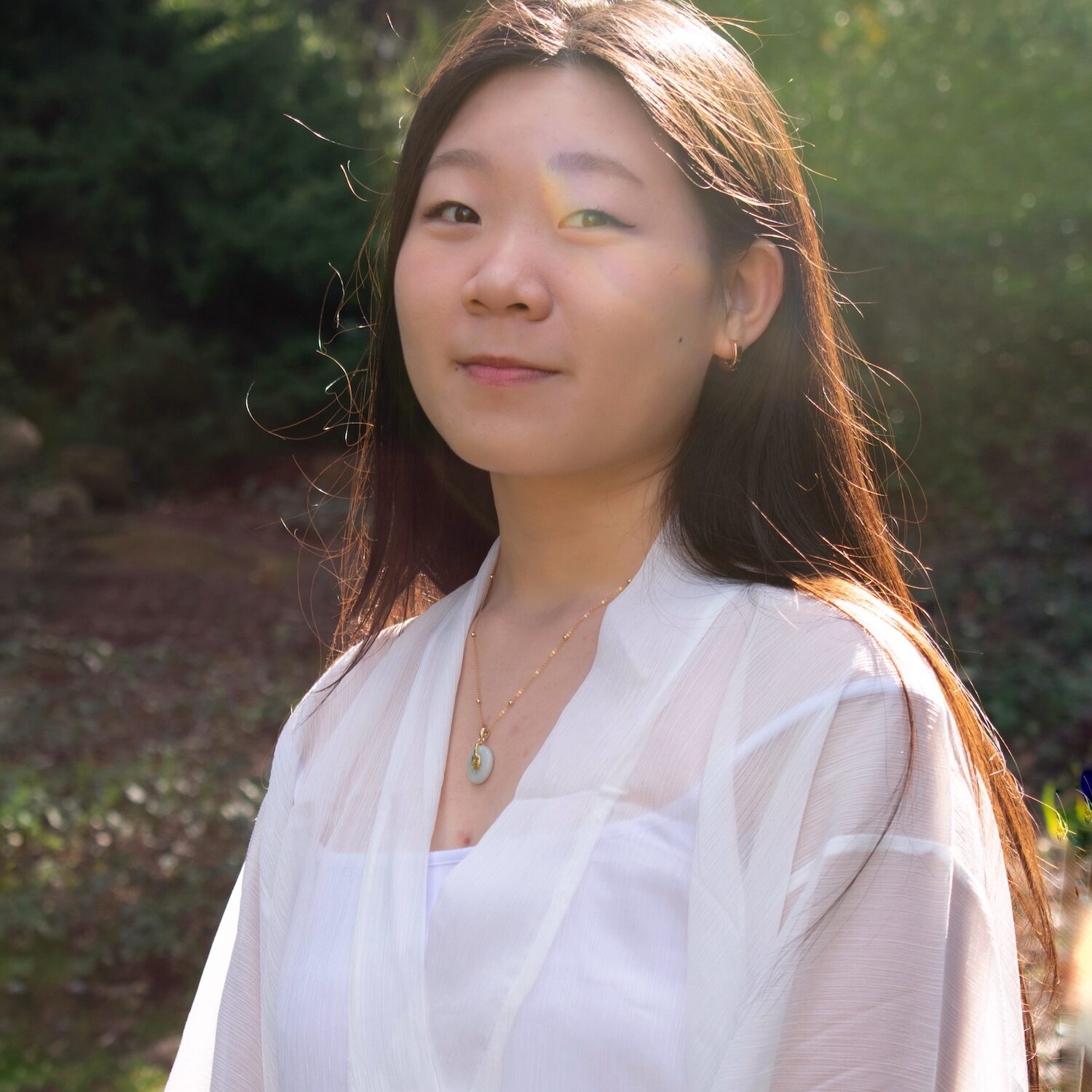
JIA LIN | Remembering: The Fuzhounese Legacy
Jia Lin is a 19 year old multidisciplinary artist and storyteller born in New York City and raised in the Greater Philadelphia Area. Jia finds joy in experimental photography, composing music, film, and sculpture. They are a second-year student at Stanford University studying Design.
Recognized as a Scholastic Art & Writing Awards National Medalist in photography, a 2022 Congressional Art Competition Award winner, an International Piano Composition Contest winner, and an alumna of the Tufts University SFMA Studio Art Intensive, Jia has also been a recipient of the Art + Justice Grant and Fellowship at the Stanford Arts Institute.
As a descendant of the Fuzhounese diaspora, Jia grew up in a community of Fuzhounese immigrants that live predominantly in New York City; along Little Fuzhou in Manhattan, Flushing in Queens, and Fuzhou Town in Brooklyn. Through oral storytelling, film photography, and sound art, she is passionate about capturing and preserving the lived experiences, joys, hopes, and dreams of her community–low-income and undocumented Fuzhounese immigrants that work as under-recognized manual laborers and service workers across the United States.
"Remembering: The Fuzhounese Legacy" builds on my previous project, "Opportunity," expanding the exploration of low-income undocumented Fuzhounese American immigrants’ lives through a mixed-media approach.
Fuzhounese Americans, primarily concentrated in New York City, experienced a peak in immigration during the 1990s, often arriving as undocumented immigrants via gang-operated smuggling trades. These individuals endured harsh conditions and exploitation in low-wage jobs to pay off their passage debt, leading to cycles of abuse and forced labor. Despite facing discrimination and isolation, Fuzhounese immigrants established neighborhoods in Manhattan, Queens, and Brooklyn, which now face gentrification and housing shortages.
"Remembering: The Fuzhounese Legacy" delves into the impacts of human trafficking, undocumented status, domestic violence, gang violence, poverty, and unsafe working conditions. It pays tribute to the vibrant yet often invisible lives of factory workers, nail salon artists, restaurant servers, and truck drivers.
Using a documentary-style mixed-media installation, I aim to capture the oral storytelling of my community. This project transcends written language, preserving voices through interviews and photographs. It documents the immigration stories, family histories, joys, hopes, and dreams of Fuzhounese Americans.
This project is a testament to the resilience of my community, celebrating the extraordinary within the ordinary. By recording these stories, I ensure that the legacy of my people is remembered and honored.

MICHELLE MAIRENA | Untitled/Unnamed/Unearthed
Fátima (they/any) is a mixed media enthusiast and third-year history student with an interest in critical historiography of the Central American isthmus and its diasporas. They are originally from the housing projects of what is today known as León, Nicaragua and proudly come from a line of feminist care workers and guerrilla archivists. Through photography, poster-making, and writing, their projects often deal with personal, familial, and resistive community storytelling around displacement, eco-colonialism, gendered violence, and the authoritarian homogenizing project of nation-states. While their projects often speak of the self and their shifting privileges and positionalities, their projects are first and foremost meditative collaborations created and informed by their communities.
This project deals with the imposition of “citizenship” into one’s body as part of the homogenizing colonial project of nation-states. Most people in the western hemisphere are given citizenship at birth based on where they are born, and that piece of paper dictates our lives–our mobility, what affects our communities and who profits from them, whether self-anointed world leaders see our lives as worth anything if we are from the mapped “Global South.” Through collage and other forms of mixed media, these prints undermine the physical structures that uphold nation-state carcerality—specifically those of the United States, such as migrant field offices and easily-ripped pieces of paper that aim to legitimize historically occupied lands–by enlarging and centering photographed migrant bodies in surreal compositions. This project rejects the logics of nationalism, the american dream, increasingly commercialized hyphenated identities such as “Nicaragüense-estadounidense,” and invites us into imagining a world—or not a world, as Yesenia Montilla says–where imaginary drawn lines do not exist.

PAMELA MARTINEZ BARRERA | Your Rage is Sacred
Pamela Martinez (she/her) is a Venezuelan filmmaker, UWC and NYU Abu Dhabi alumni, and MFA graduate in the Documentary Media Program at Stanford. She is interested in investigating systems of care through cinema. In 2020 she was awarded NYUAD’s Summer Film Grant with which she developed her first short documentary Estado Fallido/Failed State (2021) which explores the political and social polarization inside the community of Canaima, where the indigenous community Pemón Kamarakoto attempts to live from tourism despite Venezuela's deep-rooted socio-economic crisis. Among her most recent projects are As I Witness, Naptime, and her undergraduate thesis project, Illegal Alien (2023), a research-based art exhibition exploring gendered migratory processes through the case of Venezuelan women migrants into the US.
Your Rage is Sacred responds to the present moment of witnessing a genocide. This project explores spaces where community organizing for activism not only brings awareness about present injustices but also is an example of how one can build systems of care, where we protect one another.
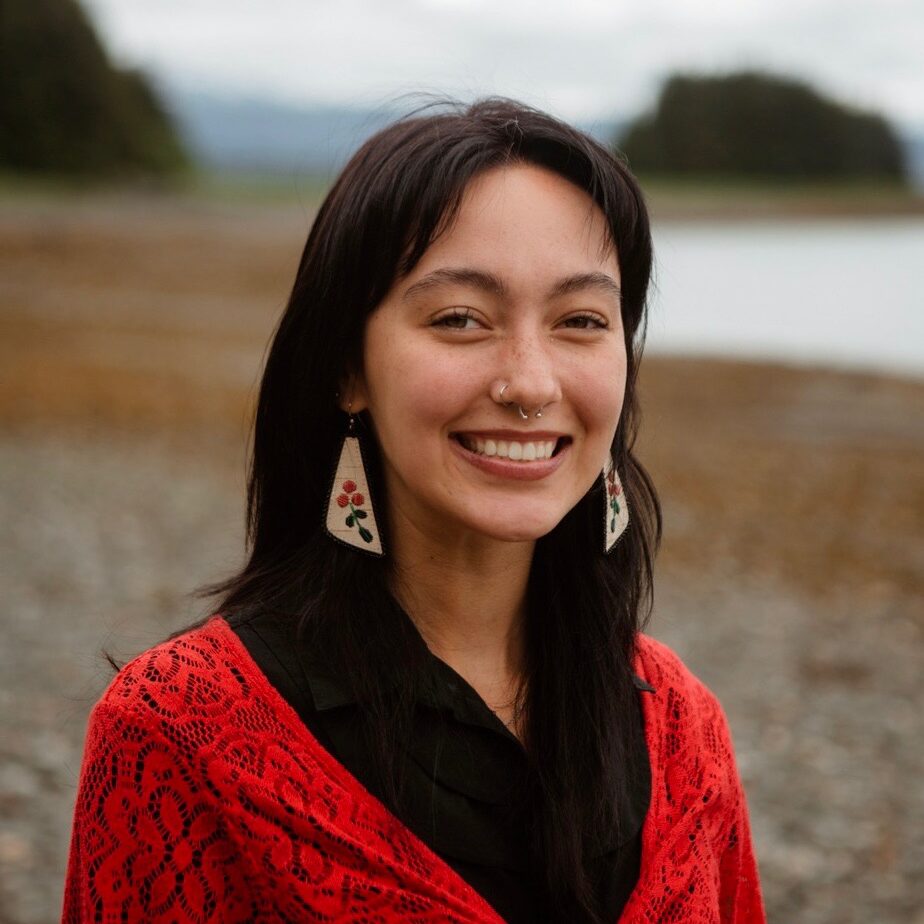
CLARA MOONEY | Kwians Kyiau
ō•kii niitaanikoō Clara Nightgun, Clara Mooney hín uu díi kya’áang; Hi, my name is Clara Mooney Nightgun, and I am a junior majoring in land systems in Earthsys. As a Haida and Blackfoot person, I am very passionate about traditional ecological knowledge, food sovereignty, and re-awakening Native languages, culture, and art. As such a lot of my work centers around fighting for Native people's right to sovereignty and the reclamation of stolen land, history, and culture. I am an illustrator, and love to create mixed media zines both for myself and to a larger audience.
This past summer in Juneau while working for my tribe I conducted work with the Haida language, providing translations for food items. While looking through the Haida dictionary, I decided to look up my father's name, Kwians Kyiau, meaning "Precious Little Bear;" except the words were not there. For a while, I panicked thinking my own recollection of something so dear was wrong. My dad's name was lost to the violent suppression of Native languages that has left my language, the Haida language, endangered. This piece came out of the complicated weight of holding memories that are painful but also offer hope. Kwians Kyiau is not lost because I hold his memory and as long as I remember him, I will always know what it means to be a precious little bear.

JASON NAVARRO-LOPEZ | Mountain Genesis
Jason Wilson Navarro-Lopez or 'Bloody Mother' is a poet, an electronic-ambient music producer, and a second-year undergraduate student majoring in Earth and Planetary Sciences. He has no "formal" musical training or creative writing experience. His art is a product of the vibrant community of South Central Los Angeles, CA – where he was born, and raised solely by his celestial mother, a Guatemalan migrant who enjoys gardening and butterflies. Growing up listening to cumbia and hip-hop mixes throughout his neighborhood has helped him develop a sound he hopes comes off as uninterpretable. This is further strengthened by poetries inspired by his own alien conspiracies, eschatology, geology, and familial turmoil.
Mountain Genesis is a multidisciplinary project fusing music production, geology, and social activism to explore the tensions revolving cultural exchanges of Guatemalan immigrants between El Pais Sibilia, Guatemala, and Los Angeles, California. Mountain Genesis as an electronic ambient album will emanate from the tensions of socioeconomic disparities, cultural identity loss, and immigration-related issues, drawing parallels with geological shifts in both regions. The project aims to bridge personal experiences with global concerns, engaging the Latine migrant community, those indifferent to their struggles, and individuals seeking a sensory exploration of these themes.
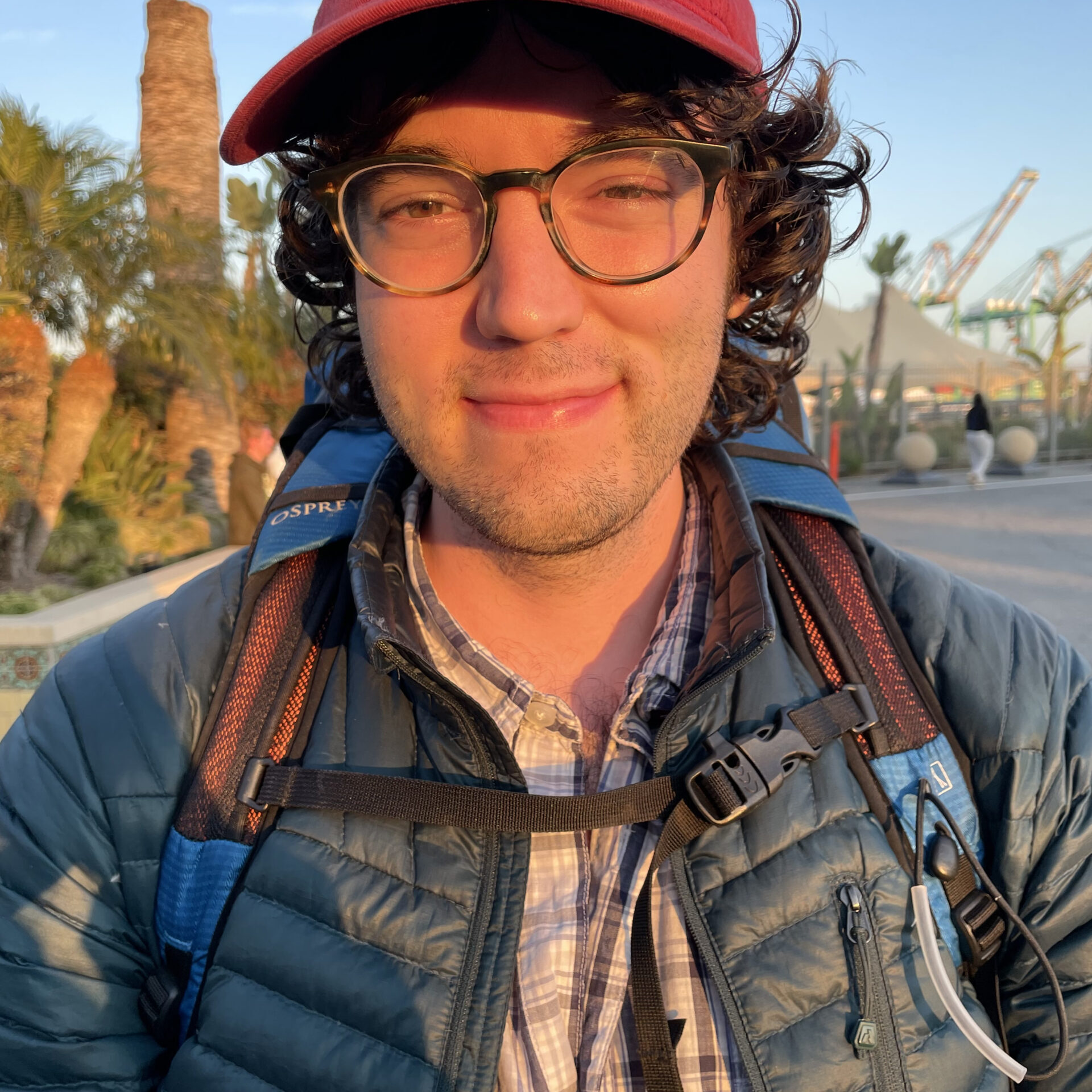
WILLIAM PANGBURN | From Puddles to Pools: A Showcase of Marine Invertebrates
Will Pangburn uses film photography and printmaking to explore the interplay of science and art. He was born and raised in New York City and recently moved to Stanford, CA to start a PhD program in Cellular and Molecular Biology. He is interested in studying the biochemistry of thermogenesis in fish and creating artwork related to marine beauty and ocean conservation. (instagram: @will_pangburn)
From Puddles to Pools: A Showcase of Marine Invertebrates is composed of a series of prints and macro film photographs depicting various marine invertebrates and beautiful scenes found in tide pools around the Bay Area, as well as a miniature guidebook for an informative introduction to tide-pooling.
A tide pool is a puddle or pool that forms in the ocean’s intertidal zone during low tide. It can be home to a large variety of flora and fauna. The Bay Area is graced with several wonderful locations to go tide-pooling and experience the special natural beauty found in tide pools firsthand. This exhibition is a celebration of the beauty of tide pools, inviting viewers to appreciate the intricacy and diversity present in these seemingly ordinary habitats.
In creating these artworks, my intention is to not only reflect upon the unique beauty to be found in tide pools, but to also speak to a deeper message, one of urgency and responsibility.
Climate change and ocean conservation can often feel amorphous and distant, but through the presentation of tide pools’ singular beauty, I hope to provide a connection to tide pools and the threats that they face. Due to their delicate, ephemeral nature, tide pools are very sensitive to physical damage, chemicals, rising CO2 levels, and ocean acidity. For example, numerous species that live in tide pools rely on calcium carbonate shells, which are very sensitive to pH change. Due to climate change, rising CO2 levels are leading to increased ocean acidification. This effect is amplified in a small tide pool environment and can cause these calcium carbonate shells to dissolve. Many of the necessary steps for ocean conservation need to happen at a global scale, but we, as individuals, can do our best to take care of our backyard with some simple steps like leaving beaches cleaner than we find them, observing these marine organisms without disturbing them, and avoiding wearing certain chemicals in the water (like bug spray and many kinds of sunscreen).
With this work, I hope to share some of the wonderous beauty and advocate for ocean conservation, even in our own backyard. You don’t have to travel far to see some amazing sea creatures, sometimes all it takes is looking down at your feet.

ESTHER RA | Juris(diction)
Esther Ra is a bilingual writer who alternates between California and Seoul, South Korea. She is the author of A Glossary of Light and Shadow (Diode Editions, 2023, recipient of the Diode Full-Length Book Prize) and book of untranslatable things (Grayson Books, recipient of the 2018 Chapbook Prize). Her work has been published in American Literary Review, Boulevard, The Florida Review, Rattle, The Rumpus, Bellingham Review, and Korea Times, among others. She has been the recipient of numerous awards, including the Pushcart Prize, 49th Parallel Award for Poetry, Women Writing War Poetry Award, and Sweet Lit Poetry Award. Esther is currently a J.D. candidate at Stanford Law School. (estherra.com)
The word jurisdiction derives from the Latin phrase iuris dictio, genitive of ius (law, right) and dictio (a saying); it is a crucial legal concept defining the power of courts to adjudicate cases, and places in which such power is exercised. This poetry project seeks to reach beyond the legal concept of jurisdiction to more broadly explore the right to speech: what narratives do we tell (or become the subjects of), and how does space shape these stories? How do structures of power (including the US legal system) silence speech, and how can we tell more just and loving stories about those impacted by the justice system? In “Juris(diction),” I seek to combine my current studies in law as a J.D. candidate at Stanford Law School with my background in English literature, theology, and creative writing. The project will culminate in (1) the completion of a poetry collection; and (2) a public spoken word performance bringing together members of the Stanford community at the law school and beyond.
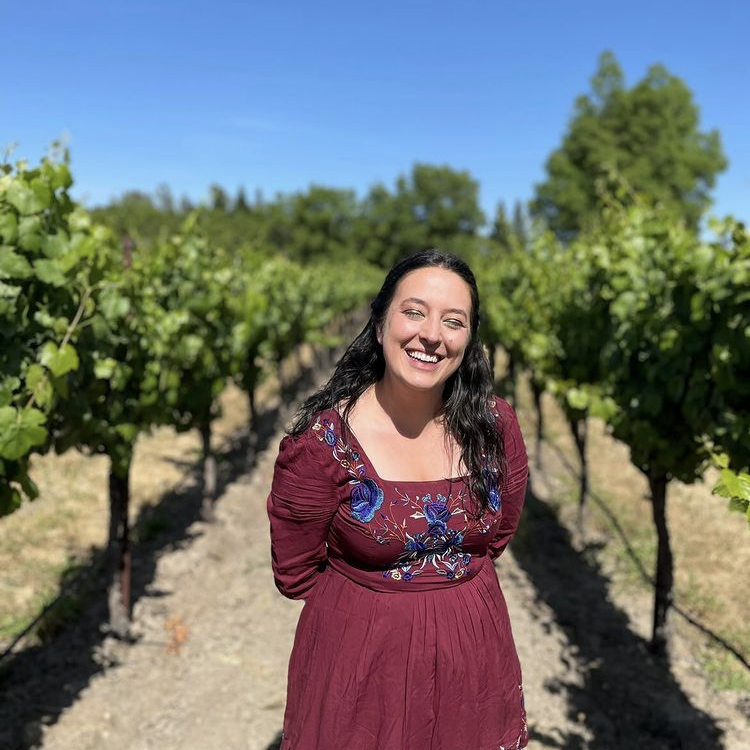
RUBY E. REED ("Lillie") | Crear Nuestra Historia: Empowering Youth and Promoting Positive Coping through Art and Storytelling Workshops in Refugee Shelters at the US-Mexico Border
Ruby E. Reed ("Lillie") (any pronouns) is a 5th year MD and MSc in Epidemiology and Clinical Research candidate at Stanford School of Medicine. Originally from rural North Carolina, Lillie's passions for storytelling and social justice both have deep roots in the mountains of Appalachia. Early on, these interests found rooting in Lillie's curiosity about the minds of others, and Lillie pursued a career in global public health and psychology -- often integrating the humanities into their work. Eventually, these interests led Lillie to medical school, with the hopes to become a child and adolescent psychiatrist. In their future work, Lillie hopes to continue exploring the intersection of community-driven mental health interventions and the humanities, and working to empower others in telling and living their own stories.
More families than ever before are awaiting court dates in refugee shelters at the US-Mexico border. Due to crowded environments, lack of services, and the culmination of the difficult experiences that forced families to flee their homes, these shelters can be incredibly difficult places to be -- especially for children. Working in partnership with a school that serves Tijuana's 2 biggest refugee shelters (El Nido, a branch of Nest Global), Stanford medical student Lillie Reed helped to create art workshops for children in the shelters. These workshops had a dual purpose: empower children as storytellers and artists, and assist them in identifying, understanding and regulating emotions. The workshops first explored different artistic media, asking questions each day about how children experience different emotions and providing artistic prompts related to those emotions. A second round of workshops then focused on storytelling -- helping kids understand their natural abilities as artists also expands to storytelling, and empowering them to tell their own stories. Storytelling workshops also explored socioemotional skills, such as mindfulness, empathy, and self-expression. Workshops took a community-oriented approach, encouraging collaboration amongst participants (ex., creating communal stories), and were child-driven, with adaptations and adjustments made to empower artists to explore the media and stories of their interest (ex., after expressed interest, participants explored memories and feelings of joy through constructing piñatas). As of June 2024, these workshops are still being implemented, with hopes to continue the program indefinitely.

ASUKULU SONGOLO | NYU'UMBA: Finding our Way Back Home
Asukulu is a junior studying International Relations with a primary focus on Africa and a secondary focus on Environment, Energy, and Natural Resources. He is from Portland, Oregon by way of the eastern Democratic Republic of Congo. In the summer of last year he founded a fashion brand called, sapé focused on highlighting the history, cultures, and traditions of Congo through clothing. His past work experiences have taken him to Cape Town, South Africa to work in arts education, Paris, France to work in a vintage fashion boutique, and this summer he will work in Beaverton, Oregon as a Nike Jordan Brand Marketing Intern. In his free time, he enjoys putting outfits together, dancing, listening to music, and learning new things.
NYU'UMBA: Finding our Way Back Home is a video essay project that serves as an exploration of natural dyeing techniques and Asukulu's cultural heritage. The video essay showcases the process of using natural dyes from The DIY Lab in Portland, Oregon as well as plants harvested from the Stanford O'Donohue Educational Farm. This project aims to highlight the importance of slow fabric production and artistry in the process of fabric making. The project's goal is to serve as an anti-thesis to the commodification of Indonesian batik-making technique that was appropriated by Dutch traders and resold, then popularized across the African continent. The three fabrics dyed here aim to symbolize the three different flags that the country had as a newly independent country Republic of Congo - Leopoldville, Zaire, then currently as the Democratic Republic of Congo. The video essay represents both a highlighting of this national history and a beginning of an exploration into Asukulu's Congolese identity in addition to his tribal identity as a Mubembe person and artist. The word Nyu'umba is Kibembe for home, the title of the project refers to a journey or odyssey to find one's way back home - because our home is waiting for us to find our way back.
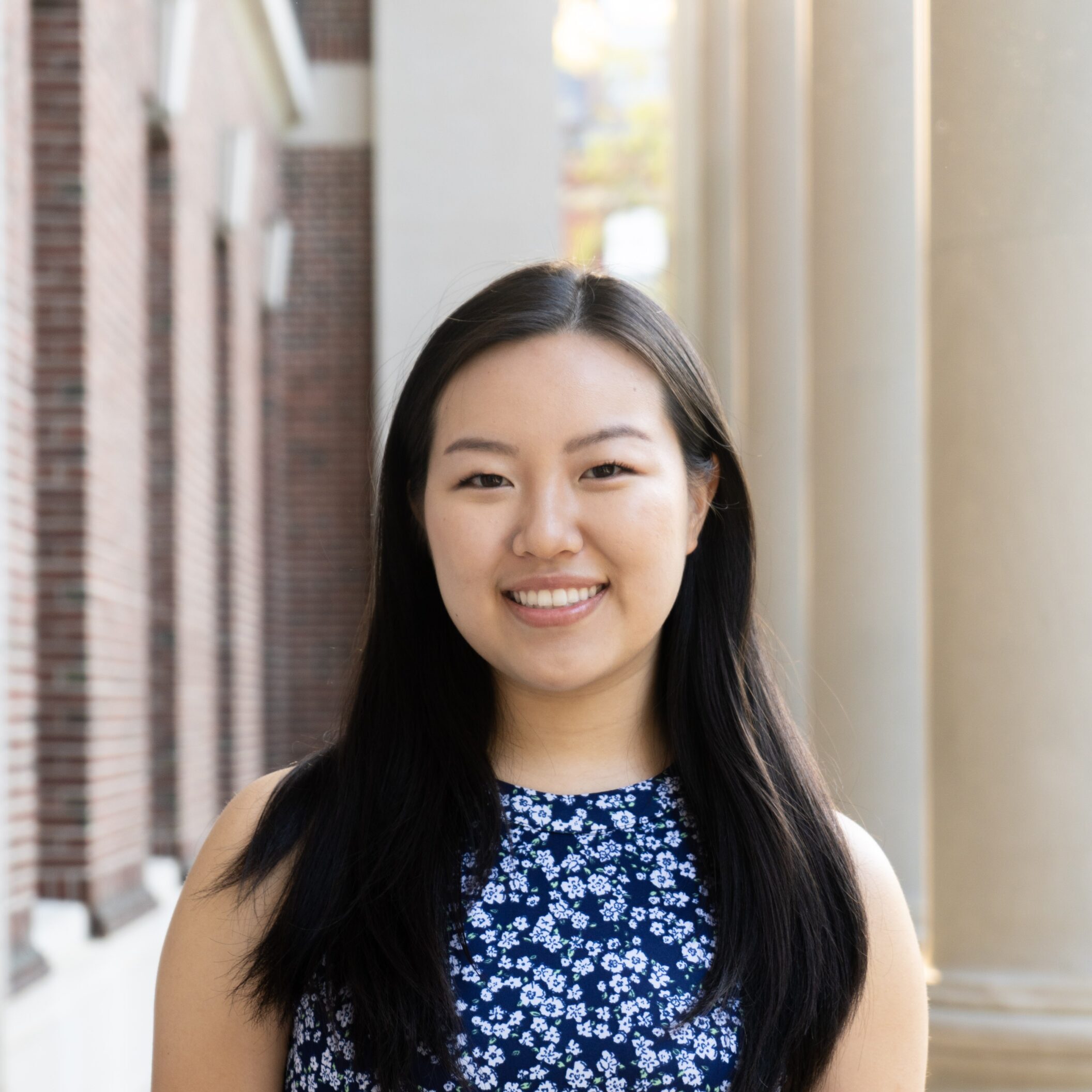
HELEN WANG | Portraiture for Humanistic Medicine
Helen Wang (she/her) is a first-year MD-PhD student at the Stanford School of Medicine. As a visual artist, she specializes in realism and figurative art through painting and drawing. Her work draws on training in classical art, Western American art, and traditional Chinese painting. She has earned numerous regional and national art awards and has several years of teaching experience in the arts and art and medicine across the Houston area, Harvard University, and Stanford. As a physician-scientist, she hopes to apply her background in the arts to improve the practice of medicine and make science more accessible.
Portraiture is an art form of intense interpersonal connection that reflects much of what characterizes an ideal relationship between healthcare provider and patient. Time is slowed, attention is focused, and curious learning about the subject takes the lead. Medicine in the status quo does not always achieve this ideal, as ongoing challenges deprive many patients of the time, empathy, and dignity that they deserve. In this project, I aim to use portraiture to promote humanization in medicine. By producing visual portraits of patients who have experienced challenging encounters with healthcare, I invite viewers to invest in recognizing and connecting with the humanity of these people.
For the first portrait in this series, I have focused on my patient partner, Juanita Waugh, who through monthly conversations has taught me about the many ways in which health systems need to improve in order to better serve patients. These works honor Juanita's service in patient advocacy and medical education, informed by her own lived experience as a breast cancer patient. The geometric quilt pattern nods to her love for crafting and represents the many experiences, perspectives, and communities that are woven together in Juanita's story, which I have had the honor of learning about through our partnership.

PAULINE MORNET, THE QUEER BEE COLLECTIVE |The Surrealist Happening: spiral bodies
[ INVITED COHORT MEMBER ]
The Queer Bee collective is composed of Alice Grace, Pauline Mornet, Taiyo Myrtil and Nolan Miranda.
The Surrealist Happening is a ritual performance rooted in the lost, unarchived, forgotten figures of feminine, queer dancers that continue to haunt the movement. In this ensemble piece, we will begin with a lecture devolving into a performance in the listening room before leading a procession up the stairs where we will assemble our altar. We invite audience members to share their dreams and shed their disillusionments, as we ask ourselves - what does our surrealism look like?

EVANI RADIYA-DIXIT | Beyond Binaries: Poems on Race, Gender, and Technology
[ INVITED COHORT MEMBER ]
“Beyond Binaries” is a collection of spoken word pieces that explores the themes of immigration, queerness, technology, identity, and diaspora. This project aims to challenge power structures rooted in rigid binaries, such as citizen vs. foreigner, femininity vs. masculinity, and techno-optimism vs. techno-pessimism. I seek to illuminate the harms of these binaries and explore the possibilities of thriving beyond them. The stories in my work will be rooted in personal and cultural experiences, as well as a family archive of letters exchanged between my mother and her father when she immigrated to the U.S. in the late 1980s. As the final product, I expect to host and record a one-hour live performance of my spoken word pieces.





